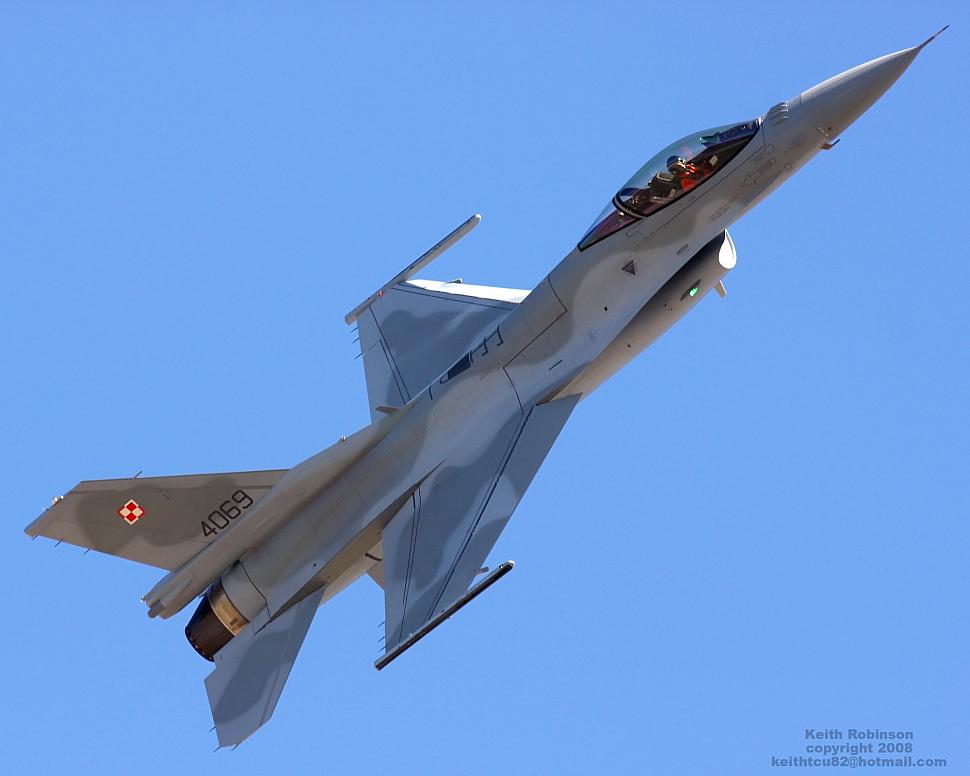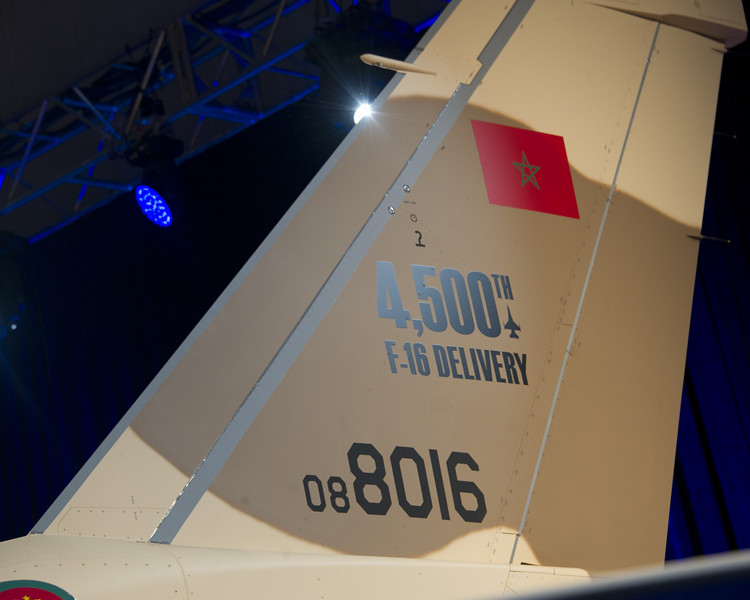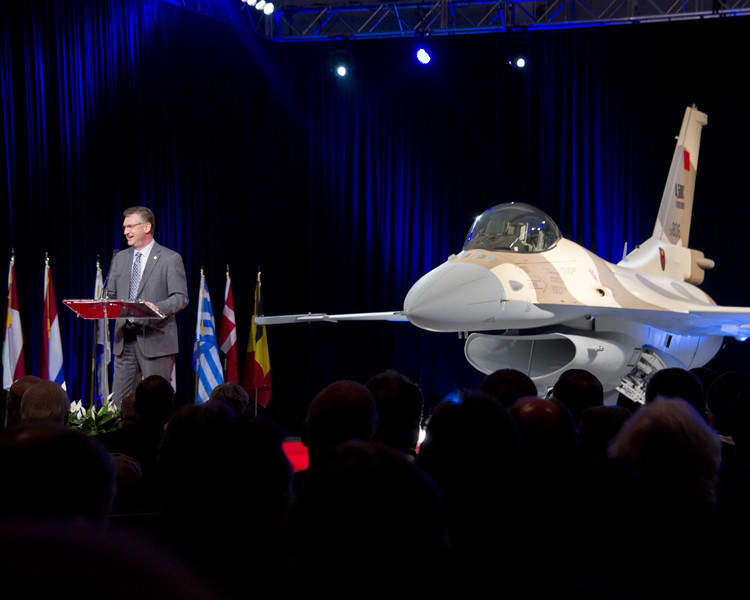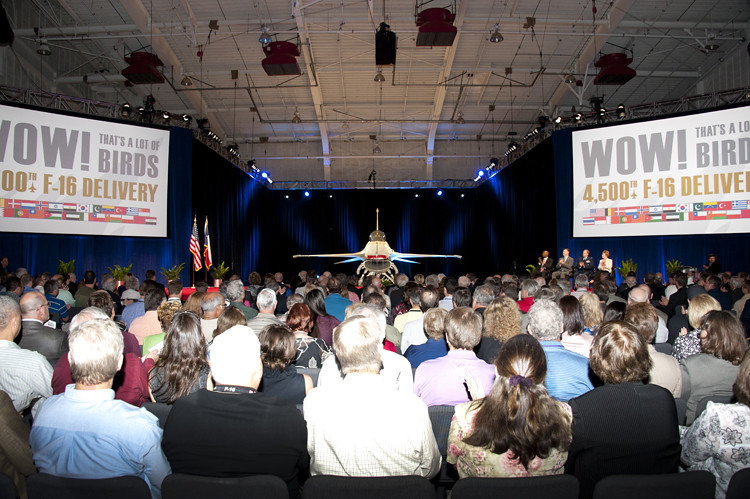Lockheed Martin to celebrate delivery of 4,500th F-16
- F-16.net Editor

- Posts: 3083
- Joined: 23 Aug 2003, 12:02
Star-Telegram wrote:Lockheed Martin to celebrate delivery of 4,500th F-16
Posted Sunday, Apr. 01, 2012
By Bob Cox
In late 1969, a conspiracy was hatched in secret all-night meetings in Washington, D.C.-area hotel rooms that would have a profound impact on military aviation and Fort Worth.
A handful of people were at the meetings: two rebel Air Force colonels, a Pentagon analyst and a General Dynamics engineer. Their goal was to create a fighter jet -- a relatively simple, inexpensive plane that could be sold by the hundreds.
Fortunately, the conspirators succeeded, probably beyond any of their wildest dreams.
On Tuesday, Lockheed Martin will celebrate delivery of the 4,500th F-16, the direct result of those late-night meetings.
It's a huge milestone for Lockheed and Fort Worth. The F-16 is arguably the finest combat airplane of the jet age. It's the principal frontline warplane of the U.S. Air Force and of the armed forces of 25 other nations.
"It's the best air-to-air fighter. Then it proved to be the most adaptable" plane for ground attack missions as well, said Pierre Sprey, a former civilian weapons analyst in the Pentagon and frequent Defense Department critic who was one of the "fighter mafia" insurgents who went up against the military establishment to launch the F-16.
As important as its capabilities, the F-16 remains a relatively low-cost aircraft. Plane No. 4,500 is bound for Morocco. Half of the F-16s ever built have been sold to foreign nations. About 1,600 jobs at Lockheed remain tied to the program.
Beyond the quality of the airplane, perhaps the signature accomplishment of the F-16 program was the process the Pentagon used to buy it. Unlike almost every other modern military aircraft program before or since, including the F-35 joint strike fighter, the F-16 was designed and built quickly, met performance specifications, and was free of technical delays and cost overruns.
<b>'A great feeling'</b>
Since the mid-1970s, the economic fortunes of Fort Worth and the surrounding region have been intertwined with the F-16. Tens of thousands of plant employees -- executives, engineers and assembly-line workers -- built careers, raised families and enjoyed comfortable lives thanks to the F-16.
It's unlikely that the old "Bomber Plant" in west Fort Worth would be operating today if not for the F-16. When General Dynamics began work on the program in 1972, the end of the F-111 bomber program was in sight, and no other contracts were in the offing.
"That plant would not exist without the F-16. No doubt about it," said Jay Miller of Arlington, an aviation historian and author of a book on the F-16.
Numerous small businesses have thrived supplying components and services to General Dynamics and Lockheed, which bought the plant in 1993.
Since the first production F-16 rolled off the assembly line in 1978, more than 3,500 have been produced in Fort Worth. Nearly 1,000 have been assembled overseas, with many Fort Worth-produced components.
Johnny Waller worked on most of those planes since getting a subassembly job in 1986. Waller, now a supervisor, says it has been a rewarding experience.
"This helped me provide for my family all these years," Waller said, and it's been a source of pride. "There's no other airplane like it. It's a great feeling to be a part of something that's been this successful."
Steve Mills, another supervisor, has spent 29 of his 30 years at the Fort Worth plant working on the F-16. In the late 1980s, at the peak of production, he once worked 30 straight days as the plant strained to produce one plane almost every day. Employment at the west Fort Worth plant topped 30,000.
"It was good money. It's been a good living," Mills said.
<b>'Spark of innovation'</b>
Four men could be called father of the F-16: Sprey, Air Force Cols. John Boyd and Everest "Rich" Riccioni and General Dynamics engineer Harry Hillaker.
Boyd, a fighter pilot, was the visionary leader of the fighter mafia. The group believed that the military services were wasting vast sums on complex, poorly conceived and poorly performing planes. They argued inside the Pentagon that the U.S. needed a small, low-cost fighter it could buy by the hundreds. The Air Force and Navy opposed the idea.
Hillaker was an aircraft designer. He and Boyd, neither of whom is still alive, mapped out the genetic code of the F-16. Hillaker oversaw the engineering process that brought it to life.
"We had a tremendous team," said Dwain Mayfield, a retired engineer who worked on the F-16 prototypes, "but there's a spark of innovation that one or two people bring to a program. Harry brought that spark. We all referred to him as the father of the F-16."
Riccioni in 1969 persuaded Air Force officials to grant a tiny $149,000 to study fighter jet technology. That was the seed money for what would become the F-16.
In January 1971, reform-minded Deputy Defense Secretary David Packard ordered a lightweight fighter competition. Five companies submitted proposals, including LTV Corp. in Dallas.
General Dynamics and Northrop were awarded contracts to design and build two prototypes. Their planes, the YF-16 and YF-17, would undergo a competitive flyoff. There was no guarantee that the Pentagon would buy any more aircraft.
General Dynamics rolled out the first YF-16 prototype in December 1973, months before Northrop completed its YF-17. The plane was transported to Edwards Air Force Base in California and reassembled for flight testing. It quickly became apparent that the YF-16 was something special.
Its performance "was eye-watering," said test pilot Phil Oestricher, a former Marine fighter pilot whose unplanned first flight in January 1974 is part of aviation lore. "There was no doubt in my mind this was an absolute winner."
As flight testing continued, the Pentagon said it would consider buying hundreds of the winning design.
In January 1975, the Pentagon declared General Dynamics the winner. The Air Force contracted for eight "full-scale development" planes to incorporate design changes and said it would buy 650 F-16s. Within months Belgium, Norway, Denmark and the Netherlands ordered 348.
<b>'Not on my watch'</b>
Performance is the top reason for the F-16's longevity, said George Standridge, a Navy F/A-18 fighter pilot turned Lockheed marketing executive.
"It's a great airplane. The platform works," Standridge said.
Another reason is that with both General Dynamics and Lockheed, Standridge said, buyers have been able to count on the company's performance. "You know when you're going to get it. You know what it's going to cost."
Today's F-16 looks little different than the early models, but the aircraft has been modified numerous times to accommodate new technology and weapons. It's not the simple lightweight plane that Boyd and Hillaker envisioned, but it still performs.
Slightly more than 3,000 F-16s are in use today worldwide, many of them built in the early years, according to the authoritative website f-16.net. The U.S. has retired its older jets, but numerous countries have upgraded their aircraft to extend their useful lives well into the future.
Lockheed has only about 70 more orders for F-16s, which would take production into early 2016. In recent years it has picked up a couple of orders per year to guarantee production a few more years.
But Bill McHenry, Lockheed's chief F-16 salesman, said production won't end then, "not on my watch."
"We continue to find nations that have a need for fourth-generation fighters out there," he said.
Iraq is the most recent nation to join the F-16 club, ordering 18 planes last year.
<b>'Most fulfilling'</b>
The success of the F-16 program is in stark contrast to the F-35 that is now under development at Lockheed.
The F-16 was designed to be relatively simple. The F-35 is an incredibly complex program -- three models, one of which has a short takeoff and vertical landing. The F-35 is years behind schedule and vastly over budget, and expected foreign buyers worry that they cannot afford enough airplanes to replace their aging F-16s.
Asked about that disparity, Lockheed spokesman Joe Stout said, "It's not valid to compare development of the early F-16 to the F-35 because of the vast differences in the airplanes and programs."
Critics, however, say complexity is at the core of everything that's gone wrong with the F-35. The Pentagon and the military forgot the lessons learned on the F-16: Keep it simple, keep costs low. "The idea you can have three common airplanes and one of them is STOVL is ridiculous," Sprey said.
The success of the F-16 is a source of immense pride to the men who helped launch the program four decades ago.
"I've talked to some of my colleagues about it," Mayfield said, and "the most fulfilling thing is that we helped change the face of tactical fighter aviation around the world."
source: http://www.star-telegram.com/2012/04/01 ... ivery.html
Asif Shamim
F-16.net Editorial staff & Patch Gallery Administration
F-16.net Editorial staff & Patch Gallery Administration
- Enthusiast

- Posts: 87
- Joined: 06 Feb 2010, 10:04
- Location: Middle east
F-35 is still light years away from attaining FOC-(Full Operational Capability) with any of the partnering nations, and its not going to do any better in significance to the already shelved F-22 Program, which in my opinion would have fared much better not only with the US and if at all it was ever cleared for export, even if it was a trimmed down version.
And with major shift in the dynamics of global politics and an ever so evident economic meltdown, the F-16 will still be the first choice, for air forces around the world, even the U.S.A.F.
And with major shift in the dynamics of global politics and an ever so evident economic meltdown, the F-16 will still be the first choice, for air forces around the world, even the U.S.A.F.
- Senior member

- Posts: 314
- Joined: 12 Jan 2012, 18:21
Awesome jet. And an even better legacy. 
Technology marches on though...
Considering the JSF's goals, when Lockmart pulls that off they will have finally surpassed their predecessors.
American Air Power forever.

Technology marches on though...
Considering the JSF's goals, when Lockmart pulls that off they will have finally surpassed their predecessors.
American Air Power forever.
- Enthusiast

- Posts: 87
- Joined: 06 Feb 2010, 10:04
- Location: Middle east
@firstimpulse,....I agree with you, presently and for the foreseeable future American Air Dominance certain....but frankly US itself is unawares of what they actually want from their blue eyed bird. Delays and cost overruns are going to be damaging to its overall sales forecast, acquisitions will dwindle....I am not being a loud critic, but the so-called common platform for all branches of the military, was a bubble which had to burst somehow(as it is now). we wont see a fully operational squadron till 2018. all partner nations are in a muddle over it, the economic recession and political agendas simply wont allow for them to acquire in large numbers.
F-16 is a legacy, still the ultimate in Fighter Technology, a true-work horse, and with various technological advancements and upgrades, this Bird will be enough to fill in for the needs of the countries using it. It is truly a Pilot's Dream Machine. I hope it crosses the golden 5,000/- mark someday.
F-16 is a legacy, still the ultimate in Fighter Technology, a true-work horse, and with various technological advancements and upgrades, this Bird will be enough to fill in for the needs of the countries using it. It is truly a Pilot's Dream Machine. I hope it crosses the golden 5,000/- mark someday.
- Forum Veteran

- Posts: 567
- Joined: 02 Sep 2006, 17:48
- Location: Poland / UK
I hope that the total number of builded aircrafts will begin with 5... Taht would be an ultimate accomplishment for that formidable, sexy, mighty jet!
ps. Polish F-16C tail no. #4069 (<a href="http://www.f-16.net/aircraft-database/F-16/airframe-profile/4632/">03-0069</a>) was the 4.400th built Viper! Looking forvard for airframe no. 5.000 !!!
!!!

ps. Polish F-16C tail no. #4069 (<a href="http://www.f-16.net/aircraft-database/F-16/airframe-profile/4632/">03-0069</a>) was the 4.400th built Viper! Looking forvard for airframe no. 5.000

PolAF F-16C block 52 #4069 has just departed NAS Fort Worth on March 19th, 2008 during its first flight after leaving the production line. [Photo by Keith Robinson]
- Senior member

- Posts: 274
- Joined: 05 Jan 2007, 22:36
- Location: Aust.
- Senior member

- Posts: 338
- Joined: 05 Aug 2009, 19:11
Couple more videos associated with the 4500th delivery ceremony:
Phil Oestricher – Memorable Moment, Flight Zero
http://www.youtube.com/watch?v=qAp4RtGKbHE
F-16 Told By Vipers (Testimonials)
http://www.youtube.com/watch?v=tTjfcj65l7M&list=UUJWcF0ex7_doPdIQGbVpDsQ&index=1&feature=plcp
Phil Oestricher – Memorable Moment, Flight Zero
http://www.youtube.com/watch?v=qAp4RtGKbHE
F-16 Told By Vipers (Testimonials)
http://www.youtube.com/watch?v=tTjfcj65l7M&list=UUJWcF0ex7_doPdIQGbVpDsQ&index=1&feature=plcp
12 posts
|Page 1 of 1
Who is online
Users browsing this forum: Google [Bot] and 0 guests







